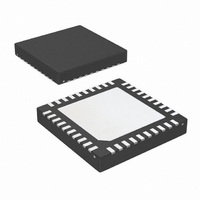LP3971SQ-2G16/NOPB National Semiconductor, LP3971SQ-2G16/NOPB Datasheet - Page 22

LP3971SQ-2G16/NOPB
Manufacturer Part Number
LP3971SQ-2G16/NOPB
Description
IC PMU FOR APPL PROCESSORS 40LLP
Manufacturer
National Semiconductor
Series
PowerWise®r
Datasheet
1.LP3971SQ-B510NOPB.pdf
(50 pages)
Specifications of LP3971SQ-2G16/NOPB
Applications
Processor
Current - Supply
60µA
Voltage - Supply
2.7 V ~ 5.5 V
Operating Temperature
-40°C ~ 85°C
Mounting Type
Surface Mount
Package / Case
40-LLP
Lead Free Status / RoHS Status
Lead free / RoHS Compliant
Other names
LP3971SQ-2G16
LP3971SQ-2G16
LP3971SQ-2G16TR
LP3971SQ-2G16
LP3971SQ-2G16TR
www.national.com
SHUTDOWN MODE
During shutdown the PFET switch, reference, control and
bias circuitry of the converters are turned off. The NFET
switch will be open in shutdown to discharge the output. When
the converter is enabled, EN, soft start is activated. It is rec-
ommended to disable the converter during the system power
up and undervoltage conditions when the supply is less than
2.7V.
SOFT START
The buck converter has a soft-start circuit that limits in-rush
current during start-up. During start-up the switch current limit
is increased in steps. Soft start is activated only if EN goes
from logic low to logic high after V
is implemented by increasing switch current limit in steps of
213 mA, 425 mA, 850 mA and 1700 mA (typ. Switch current
limit). The start-up time thereby depends on the output ca-
pacitor and load current demanded at start-up. Typical start-
up times with 10 μF output capacitor and 1000 mA load
current is 390 μs and with 1 mA load current is 295 μs.
LDO - LOW DROP OUT OPERATION
The LP3971 can operate at 100% duty cycle (no switching;
PMOS switch completely on) for low drop out support of the
output voltage. In this way the output voltage will be controlled
down to the lowest possible input voltage. When the device
operates near 100% duty cycle, output voltage ripple is ap-
proximately 25 mV. The minimum input voltage needed to
support the output voltage is
•
•
•
I
R
R
LOAD
DSON, PFET
INDUCTOR
V
IN, MIN
= I
LOAD
* (R
Load Current
Drain to source resistance of PFET
switch in the triode region
Inductor resistance
DSON, PFET
IN
+ R
reaches 2.7V. Soft start
INDUCTOR
) + V
Switching Energy RBW = 300 Hz
OUT
22
SPREAD SPECTRUM FEATURE
Periodic switching in the buck regulator is inherently a noisier
function block compared to an LDO. It can be challenging in
some critical applications to comply with stringent regulatory
standards or simply to minimize interference to sensitive cir-
cuits in space limited portable systems. The regulator’s
switching frequency and harmonics can cause “noise” in the
signal spectrum. The magnitude of this noise is measured by
its power spectral density. The power spectral density of the
switching frequency, F
signers want to be as low as practical to reduce interference
to the environment and subsystems within their products. The
LP3971 has a user selectable function on chip, wherein a
noise reduction technique known as “spread spectrum” can
be employed to ease customer’s design and production is-
sues.
The principle behind spread spectrum is to modulate the
switching frequency slightly and slowly, and spread the signal
frequency over a broader bandwidth. Thus, its power spectral
density becomes attenuated, and the associated interference
electro-magnetic energy is reduced. The clock used to mod-
ulate the LP3971 buck regulator can be used as a spread
spectrum clock via 2 I
Register 1 (SCR1) 8h’80) bits bk_ssen, and slomod. With this
feature enabled, the intense energy of the clock frequency
can be spread across a small band of frequencies in the
neighborhood of the center frequency. This results in a re-
duction of the peak energy!
The LP3971 spread spectrum clock uses a triangular modu-
lation profile with equal rise and fall slopes. The modulation
has the following characteristics:
•
•
•
•
The center frequency:
The modulating frequency,
Peak frequency deviation:
Modulation index
20180741
C
2
, is one parameter that system de-
C control register (System Control
Δ_f = ±100 kHz (or ±5%)
β = Δ_f/f
f
M
= 6.8 kHz or 12 kHz.
F
C
M
= 2 MHz, and
= 14.7 or 8.3











